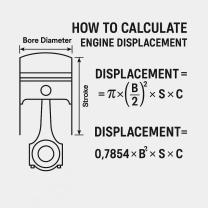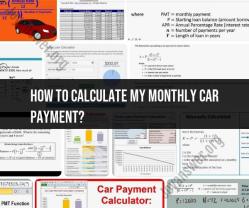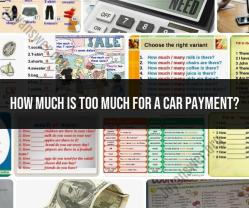How much is too much for a car payment?
Determining an affordable car payment depends on various factors, including your income, expenses, financial goals, and overall financial situation. As a general guideline, financial experts often recommend that your total monthly car expenses, including car payment, insurance, fuel, maintenance, and registration, should not exceed 15% to 20% of your gross monthly income.
Within this overall guideline, your car payment specifically should ideally be no more than 10% of your gross monthly income. This ensures that you have enough room in your budget to cover other essential expenses, save for emergencies and retirement, and avoid becoming financially stretched.
Additionally, consider the following factors when determining how much is too much for a car payment:
Debt-to-Income Ratio: Your total debt payments, including your car payment, should not exceed a certain percentage of your gross monthly income. Lenders typically use a debt-to-income ratio (DTI) to assess your ability to manage additional debt responsibly. A DTI ratio of 36% or lower is generally considered manageable.
Emergency Savings: It's essential to have an emergency fund in place to cover unexpected expenses, such as medical bills, home repairs, or job loss. Make sure you prioritize saving for emergencies before committing to a higher car payment.
Long-Term Financial Goals: Consider how your car payment fits into your long-term financial goals, such as saving for a down payment on a home, paying off high-interest debt, or investing for retirement. If a higher car payment prevents you from making progress toward these goals, it may be too much.
Interest Rate and Loan Term: Be mindful of the interest rate and loan term when financing a car. A longer loan term may result in lower monthly payments but can cost you more in interest over the life of the loan. Aim for the shortest loan term you can afford to minimize interest expenses.
Resale Value and Depreciation: Choose a car that holds its value well and depreciates at a slower rate to minimize the impact of depreciation on your finances. Avoid purchasing a car that will quickly lose value and leave you owing more than it's worth.
Ultimately, it's crucial to assess your financial situation carefully and choose a car payment that fits comfortably within your budget and aligns with your financial goals. Avoid stretching your budget too thin to afford a car that may ultimately strain your finances in the long run.
What factors should be considered when determining an excessive car payment amount?
Determining an "excessive" car payment amount depends on various factors specific to your financial situation. Here are some key considerations to help you assess affordability:
1. Debt-to-Income Ratio (DTI):
- This ratio measures your monthly debt obligations (including car payments) compared to your gross monthly income.
- Ideally, your total DTI should be below 36%, and your car payment alone should ideally be below 15% of your gross monthly income.
- Exceeding these recommended ratios can indicate financial strain and make it challenging to manage other expenses.
2. Emergency Fund:
- Having a sufficient emergency fund is crucial for unforeseen circumstances.
- Aim to have 3-6 months of living expenses saved in an easily accessible account before committing to a significant car payment.
- Large car payments can deplete your emergency savings, leaving you vulnerable to financial hardship in case of emergencies like job loss or medical bills.
3. Overall Financial Goals:
- Consider your short-term and long-term financial goals.
- Large car payments can limit your ability to save for other priorities like retirement, a down payment on a house, or other investments.
- Evaluate if the car payment aligns with your overall financial aspirations.
4. Alternative Transportation Options:
- Explore alternative transportation options like public transportation, carpooling, or ride-sharing services.
- These options can significantly reduce your transportation costs compared to owning a car, especially if your car payment is a significant financial burden.
5. Car Value and Loan Terms:
- The total cost of ownership should be considered, including car payment, insurance, fuel, maintenance, and potential repairs.
- Evaluate the car's depreciation rate and ensure the loan term isn't extending far beyond the car's useful life, potentially leaving you "underwater" on the loan (owing more than the car's worth).
6. Lifestyle Needs:
- Consider your lifestyle needs and daily commute when selecting a car.
- A fuel-efficient, less expensive car might be sufficient if you primarily use it for short commutes, while a larger vehicle might be necessary for a family or frequent long-distance travel.
Remember, a responsible car payment should be one that you can comfortably afford after considering all your financial obligations and long-term goals. It's crucial to prioritize financial stability and avoid stretching yourself too thin by committing to an excessive car payment.













